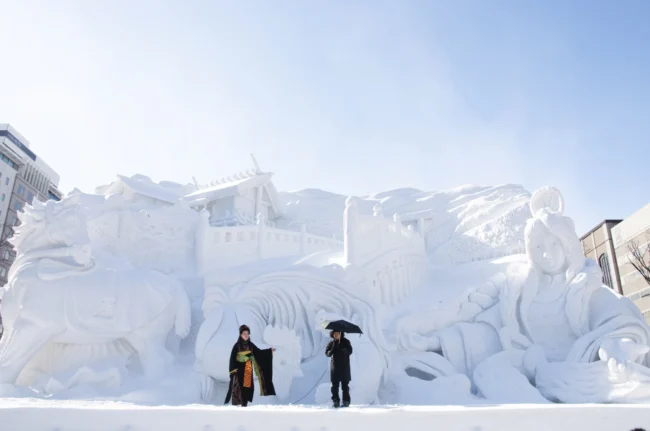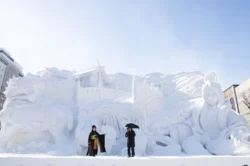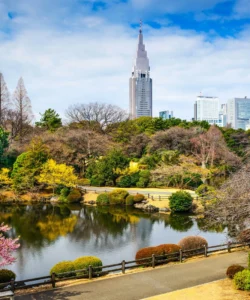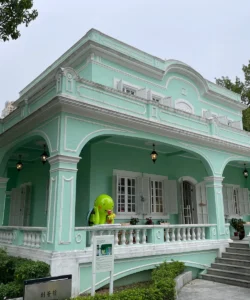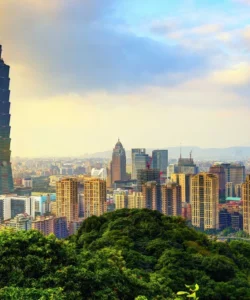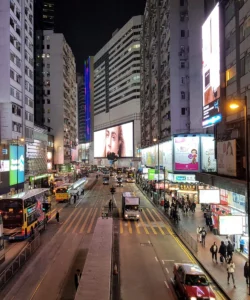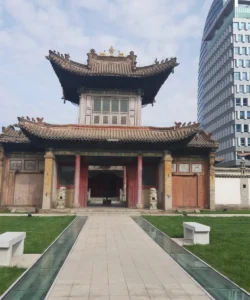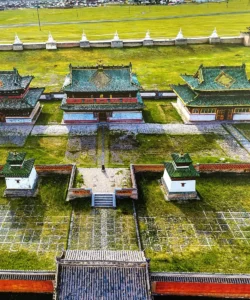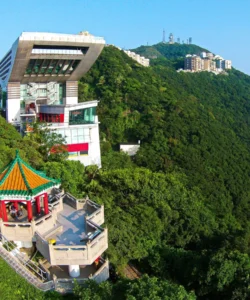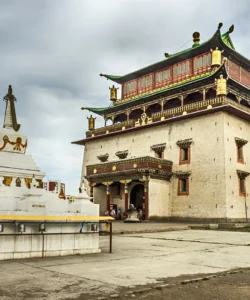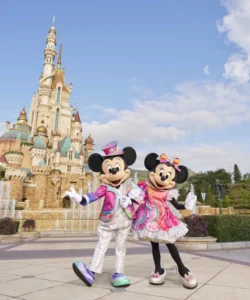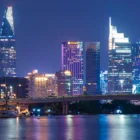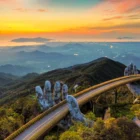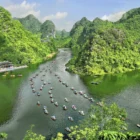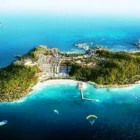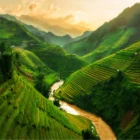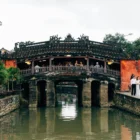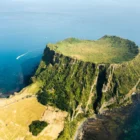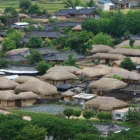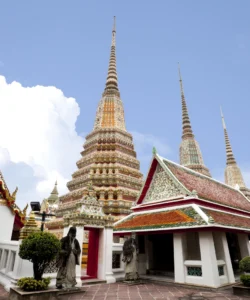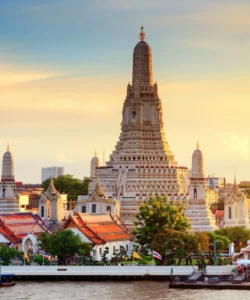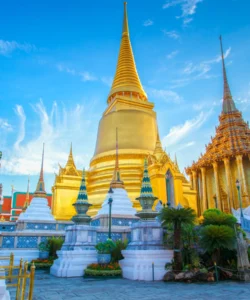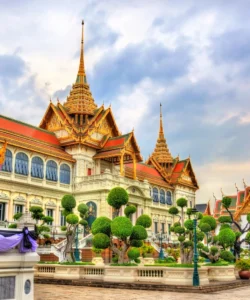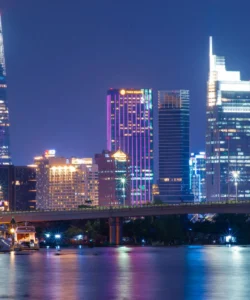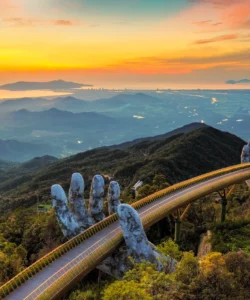Prepare to be enchanted by the Sapporo Snow Festival, a breathtaking “Wonder” that transforms a bustling city into a magical, ephemeral world of ice and snow.
Name: Sapporo Snow Festival (さっぽろ雪まつり – Sapporo Yuki-matsuri)
Address: The festival is spread across multiple sites in Sapporo, Hokkaido, Japan:
- Odori Park Site (大通公園会場): Nishi 1-chome to Nishi 12-chome, Odori, Chuo-ku, Sapporo, Hokkaido. This is the main site.
- Susukino Site (すすきの会場): Along Ekimae-dori in the Susukino entertainment district (from Minami 4-jo to Minami 7-jo).
- Tsudome Site (つどーむ会場): Sakaemachi, Higashi-ku, Sapporo, Hokkaido. (Note: Tsudome is sometimes temporarily closed or its offerings may vary due to various circumstances, so check official announcements).
How to get there:
Sapporo, the capital of Hokkaido, is easily accessible, and the festival sites are well-connected within the city.
- To Sapporo City:
- By Plane: Fly into New Chitose Airport (CTS), the main gateway to Hokkaido. Direct flights are available from major Japanese cities (Tokyo, Osaka, Nagoya, Fukuoka) and some international destinations.
- From New Chitose Airport, take the JR Rapid Airport Express train to Sapporo Station (approx. 37 minutes). Buses and taxis are also available.
- Alternatively, take a highway bus from New Chitose Airport directly to Odori Park.
- To the Festival Sites (within Sapporo):
- Odori Park Site: A short 15-minute walk south from Sapporo Station, or a 2-minute subway ride (Namboku or Toho Line) to Odori Station.
- Susukino Site: One subway stop from Odori Station (Namboku Line) to Susukino Station, or a 15-minute walk from Odori Park.
- Tsudome Site: This site is further from the city center. From Sapporo Station, take the Toho Line subway to Sakaemachi Station, then a shuttle bus to Tsudome (operates only during festival hours). It’s typically recommended to check official shuttle bus schedules.
Landscape and Architecture (of Snow and Ice!):
The “landscape and architecture” of the Sapporo Snow Festival are entirely ephemeral, crafted from the very elements of winter: snow and ice.
- Odori Park Site: The heart of the festival. This 1.5 km long park is transformed into a majestic outdoor art gallery.
- Giant Snow Sculptures: These are the festival’s most iconic features. Massive, often multi-story, intricate snow sculptures depicting famous landmarks (e.g., temples, castles, international buildings), anime characters, historical figures, or abstract concepts. These are often created by the Japan Self-Defense Forces, local teams, and international artists.
- Projection Mapping: In the evenings, many of the largest snow sculptures become canvases for spectacular projection mapping shows, bringing the frozen art to life with dynamic visuals and music.
- International Snow Sculpture Contest: Teams from around the world compete, showcasing a diverse range of artistic styles and themes.
- Smaller Snow Sculptures: Hundreds of smaller, detailed snow sculptures created by citizens and various organizations fill the park’s blocks.
- Winter Sports: Sometimes includes snow slides, ice rinks, and even ski jumping competitions (like the HTB Park Air Square)
- Susukino Site: This vibrant entertainment district is transformed into “Susukino Ice World.”
- Ice Sculptures: Focused entirely on clear and intricate ice sculptures, often illuminated with dazzling lights. These range from animals and mythical creatures to more abstract designs, and sometimes include an “Ice Bar” where you can enjoy drinks in a frosty setting.
- Tsudome Site: A more interactive and family-friendly venue.
- Snow Slides and Activities: Features giant snow slides, snow rafting, snow mazes, and various snow-related games suitable for children and adults.
- Indoor Facilities: The Tsudome itself is an indoor dome, offering a warm space with food stalls and rest areas, crucial for colder days.
What makes it famous:
The Sapporo Snow Festival is world-renowned for several reasons:
- Monumental Snow and Ice Sculptures: Its signature is the sheer scale and artistic detail of its giant snow sculptures and the brilliance of its ice sculptures. These are truly breathtaking and unique works of temporary art.
- International Appeal: It’s not just a local event; the International Snow Sculpture Contest attracts artists from dozens of countries, making it a global showcase of winter artistry.
- Magical Night Illuminations and Projection Mapping: The transformation of the sculptures with colorful lights and cutting-edge projection mapping at night creates an unforgettable, almost magical atmosphere.
- Urban Winter Wonderland: It turns a major modern city into a fantastical winter wonderland, allowing millions to experience the beauty of snow and ice art without venturing deep into wilderness.
- Accessibility and Infrastructure: Despite the winter conditions, Sapporo’s excellent public transportation and amenities make the festival surprisingly easy to navigate and enjoy.
- Long-Standing Tradition: Originating in 1950 with local students making snow sculptures, it has grown exponentially to become one of Japan’s premier winter festivals, attracting over two million visitors annually.
Differences from some other wonders:
- Ephemeral Nature: Unlike permanent architectural wonders (e.g., temples, castles) or enduring natural wonders (e.g., mountains, gorges), the Sapporo Snow Festival is a temporary wonder. Its magnificent “architecture” of snow and ice exists for only about a week each year, making the experience fleeting and highly anticipated.
- Artistic Creation, Not Natural Formation: While it uses natural elements (snow and ice), the “wonder” comes from human artistry and engineering. It’s not a natural landscape (like a gorge or a lake) but a testament to human creativity and skill in transforming winter’s bounty into intricate art.
- City-Wide Festival vs. Single Location: Instead of being confined to one specific site, the Sapporo Snow Festival spans across multiple distinct venues throughout the city, each offering a different type of experience (grand sculptures, ice art, interactive snow fun).
- Interactive and Experiential: Beyond just viewing, the festival encourages interaction through ice slides, snow activities, and a vibrant street food scene, offering a more active and sensory experience than many other passive sightseeing wonders.
- Cultural Blend: While rooted in a Japanese setting, the festival’s international sculpture contest and the diverse themes of its sculptures often incorporate global elements, giving it a broader cultural reach than some more strictly traditional Japanese festivals.
